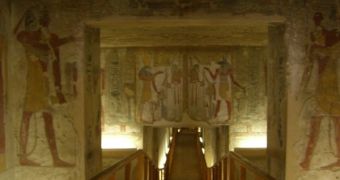The Valley of the Kings, on the banks of the Nile River, opposite to the ancient city of Thebes, is the necropolis where all pharaohs and nobles from the New Kingdom (16th to 11th century BC) were entombed. For over 500 years, numerous funeral monuments were built at the location. Since it began being explored, the Valley has yielded phenomenal finds and has considerably furthered our knowledge of ancient Egypt. Now, the necropolis is endangered by the fact that most of the structures are built atop rock-fracture concentrations underground, e! Science News reports.
When ancient Egyptian builders set out to construct the monuments, they might have purposefully built them atop these dangerous areas, because the limestone was a lot easier to carve at those locations. However, while that may have been appropriate thousands of years ago, it now poses a large number of challenges to curators, whose job is to keep the structures intact.
“Previously, I noticed that some tomb entrances in the Valley of Kings, Luxor, Egypt, were aligned on fracture traces and their zones of fracture concentration,” Pennsylvania State University (Penn State) Department of Integrative Arts instructor in digital photography Katarin A. Parizek says.
“From my observations, it seems that tomb builders may have intentionally exploited these avenues of less resistant limestone when creating tombs,” she adds. The areas of fracture can be anywhere between five and 40 feet wide and can reach up to a mile in length. Experts now believe that these areas were intensely exploited in Egypt, either for digging up water wells, or constructing tombs, as digging and excavating there was a lot easier than in the surrounding regions, where the limestone was a block.
“We have now documented nine tombs in detail, photographing and mapping the entire tombs inside and out, and preliminary observations have been made in another ten, which still have to be mapped in detail. We have recorded 14 more tombs through field observations, but still need to map and photograph these as well,” Parizek says of the efforts. More than 30 out of 63 tombs thus far found in the Valley have been identified as lying atop fracture zones. In addition to the damage the zones themselves pose, water can also infiltrate the tombs much easier through these areas, which triggers an additional set of problems.
“Archaeologists try very hard to mitigate flooding in the tombs, but it becomes even harder if there are tombs flooding that no one knows about,” Parizek concludes.

 14 DAY TRIAL //
14 DAY TRIAL //